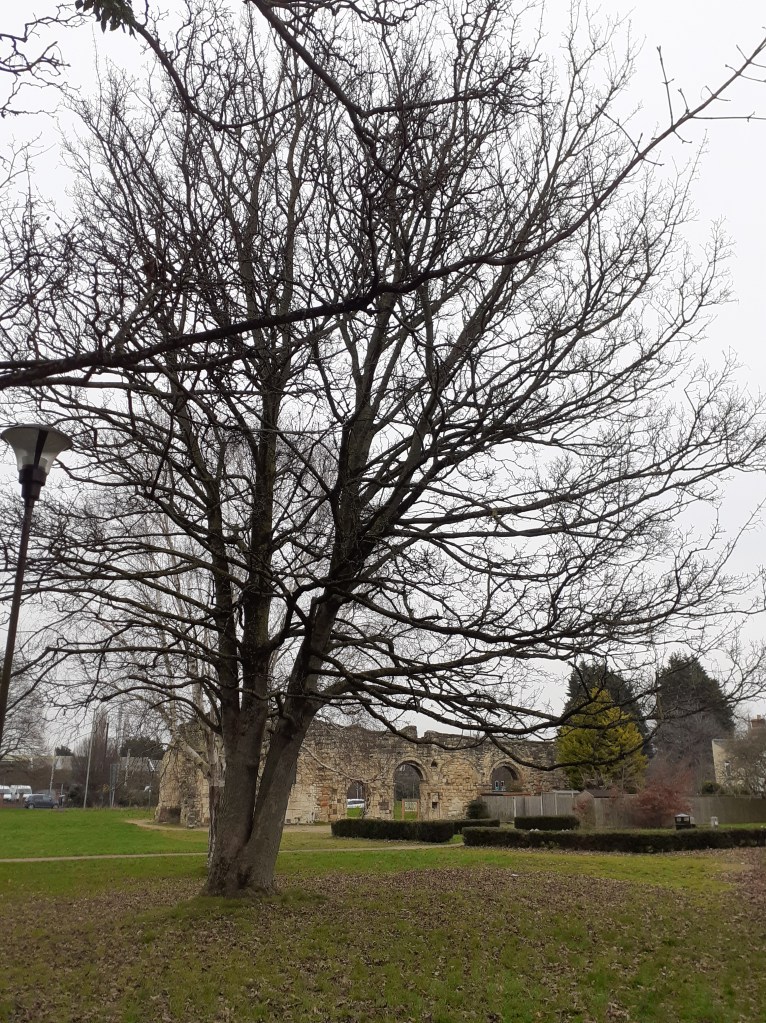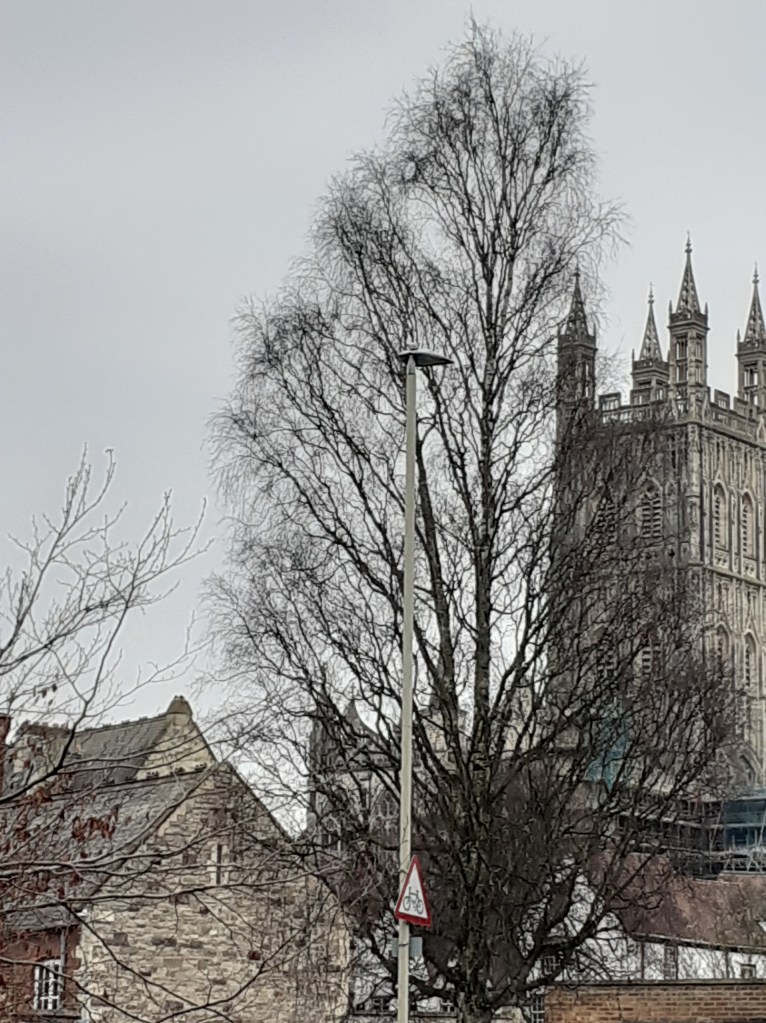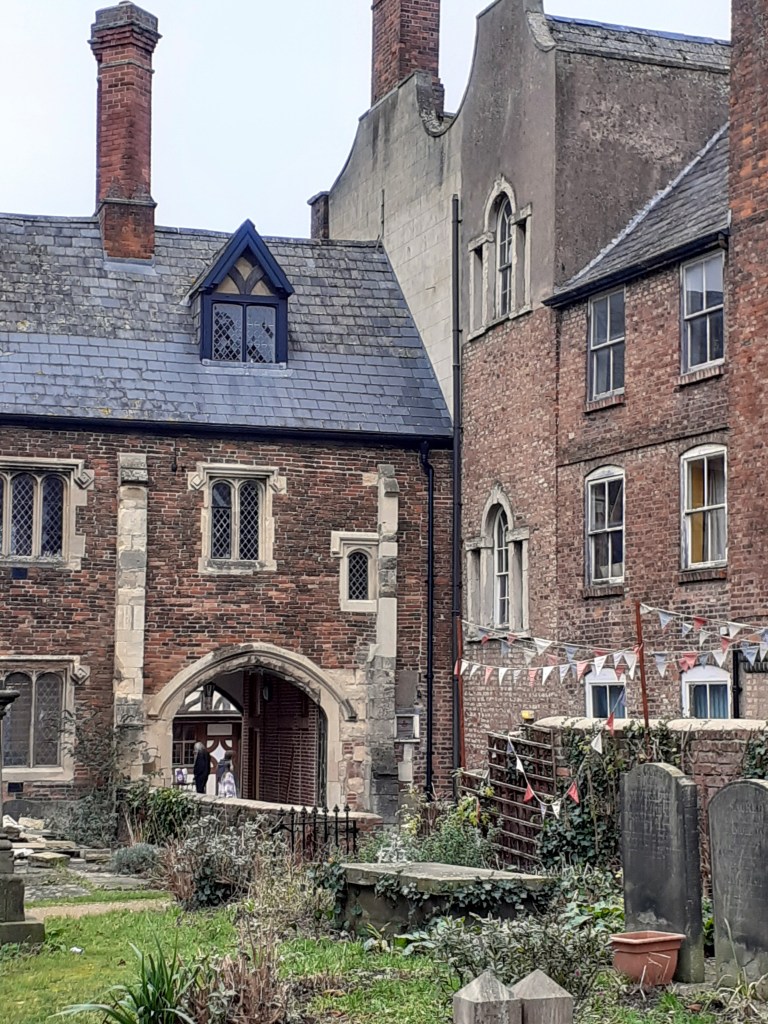OLD CITY, NEW HOME
by contemplativeinquiry

Above, a city park containing monastic ruins. I am beginning to make sense of a new habitat. The distance door-to-door is only about ten miles from the old one. But it feels very different. Stroud the Cotswold mill town is hilly and hard on the older pedestrian. Gloucester is an old English city on the river Severn, much flatter. The centre, where we now live, has become highly pedestrian friendly in recent years. This was a key motivator for our move and it already feels transformational.
On an exploratory amble on Sunday, Elaine and I were very aware of history. St. Oswald’s Priory, in the picture above, was founded by Lady Aethelflaed of Mercia, daughter of Alfred the Great, around 900. The Priory Church, initially dedicated to St. Peter, was constructed from recycled Roman stones. (The Romans founded the city, as Glevum, in the first century CE, and it never quite died after their departure from Britain). In Aetheflaed’s time it was a bold and unusual move to build a church as there were frequent Viking raids. Quite possibly Aethelflaed and her husband were later interred in the crypt. Archaeological excavations in the 1970s revealed a 10th century fragment of carved slab from the grave of someone of high importance.
In the centuries that followed St Oswald’s grew rich as a place of pilgrimage and was at the centre of a large parish. But later it declined, as institutions do. It was almost literally in the shadow of the more successful Abbey of St. Peter, now Gloucester Cathedral, where the power of the church was now based. Architecturally, the cathedral (below) still dominates the city.

When Elaine and I were walking together on Sunday, the bells were ringing and we found ourselves enjoying this as an expression of the old city’s identity. As in other old cathedral cities, the cathedral is characteristically approached through narrow, often arched lanes and then appears magnificently in front of us.


We have another church, St. Mary-Le-Crypt (below), even closer to home, and cut through its churchyard to get to a major traditional shopping street. Like the cathedral, it continues to serve Anglican (Episcopalian) worshippers and to be part of the wider community.


I have as yet no idea what effect, if any, living in Gloucester will have on my contemplative inquiry, nested as it is in Druidry and Earth spirituality. It is much too early to tell. From the perspective of the living moment, I am delighted to be soaking in new impressions, aware that this is where I live now. Looking out, this is what I will frequently see. These sights are part of the texture of my daily experience now, and I welcome them as such. It greet a new way of being at home.

This looks beautiful. Such rich history surrounding you. I can imagine it’s quite different than you previous hometown, but as Bilbo Bagins said: “The Road goes ever on and on. Down from the door where is began. Now far ahead the Road has gone, and I must follow, if I can.”
Wishing you and Elaine many years of happiness and inspiration /|\
Thanks Raymond, for these kind thoughts. Blessings, James /|\
This looks beautiful. Such rich history surrounding you. I can imagine it’s quite different than you previous hometown, but as Bilbo Baggins said: “The Road goes ever on and on. Down from the door where it began. Now far ahead the Road has gone, and I must follow, if I can.”
Wishing you and Elaine many years of happiness and inspiration /|\
Thanks Raymond, for these kind thoughts. Blessings, James /|\
Wonderful and amazing. Looks like a good move. Enjoy and be well.
Thanks Bart! My best wishes to you too,
Thanks Bart. My best wishes to you, too.
James, it looks like an interesting city. You and Elaine have much now ground to explore. It is quite a change from your previous home.
Thanks Ron. Yes – it is quite a change!
How lucky you are to be surrounded by such beauty! I wish you all the best in your new home.
Thanks Hazel! Blessings, James
Oh that does look nice. Wishing you wonder and joy in your new home.
Thanks for your comment Linda. The move certainly feels good so far!